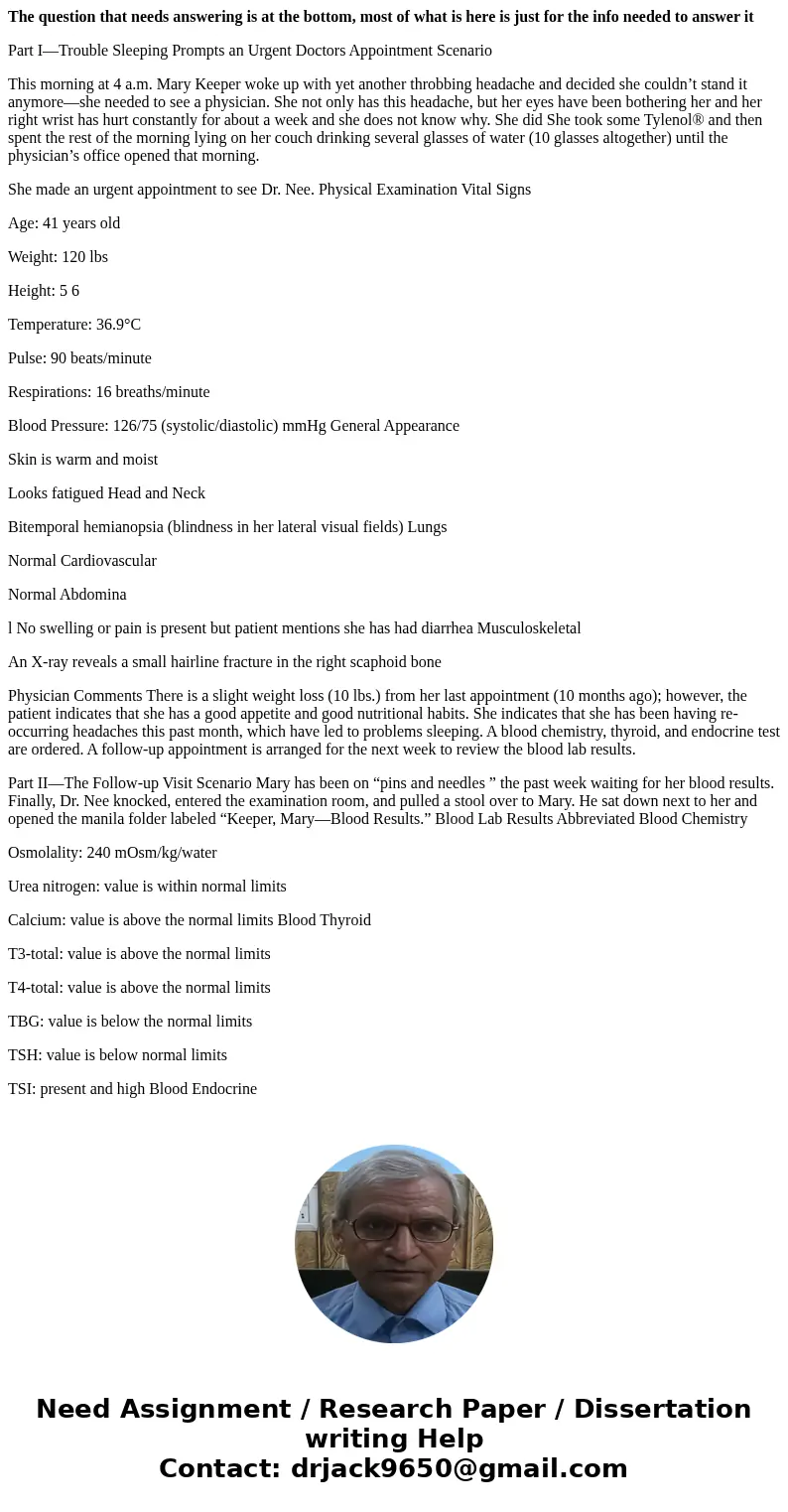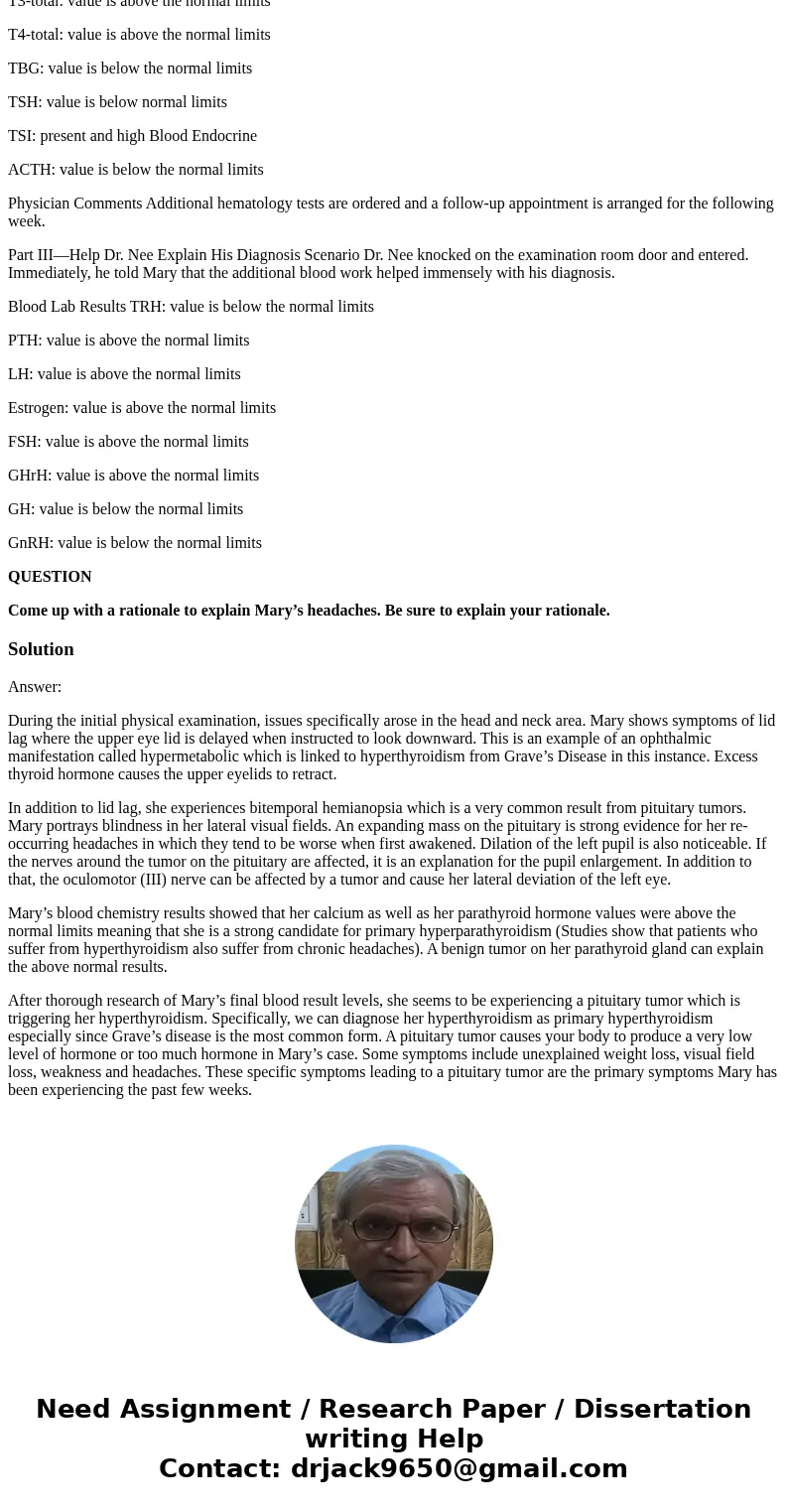The question that needs answering is at the bottom most of w
The question that needs answering is at the bottom, most of what is here is just for the info needed to answer it
Part I—Trouble Sleeping Prompts an Urgent Doctors Appointment Scenario
This morning at 4 a.m. Mary Keeper woke up with yet another throbbing headache and decided she couldn’t stand it anymore—she needed to see a physician. She not only has this headache, but her eyes have been bothering her and her right wrist has hurt constantly for about a week and she does not know why. She did She took some Tylenol® and then spent the rest of the morning lying on her couch drinking several glasses of water (10 glasses altogether) until the physician’s office opened that morning.
She made an urgent appointment to see Dr. Nee. Physical Examination Vital Signs
Age: 41 years old
Weight: 120 lbs
Height: 5 6
Temperature: 36.9°C
Pulse: 90 beats/minute
Respirations: 16 breaths/minute
Blood Pressure: 126/75 (systolic/diastolic) mmHg General Appearance
Skin is warm and moist
Looks fatigued Head and Neck
Bitemporal hemianopsia (blindness in her lateral visual fields) Lungs
Normal Cardiovascular
Normal Abdomina
l No swelling or pain is present but patient mentions she has had diarrhea Musculoskeletal
An X-ray reveals a small hairline fracture in the right scaphoid bone
Physician Comments There is a slight weight loss (10 lbs.) from her last appointment (10 months ago); however, the patient indicates that she has a good appetite and good nutritional habits. She indicates that she has been having re-occurring headaches this past month, which have led to problems sleeping. A blood chemistry, thyroid, and endocrine test are ordered. A follow-up appointment is arranged for the next week to review the blood lab results.
Part II—The Follow-up Visit Scenario Mary has been on “pins and needles ” the past week waiting for her blood results. Finally, Dr. Nee knocked, entered the examination room, and pulled a stool over to Mary. He sat down next to her and opened the manila folder labeled “Keeper, Mary—Blood Results.” Blood Lab Results Abbreviated Blood Chemistry
Osmolality: 240 mOsm/kg/water
Urea nitrogen: value is within normal limits
Calcium: value is above the normal limits Blood Thyroid
T3-total: value is above the normal limits
T4-total: value is above the normal limits
TBG: value is below the normal limits
TSH: value is below normal limits
TSI: present and high Blood Endocrine
ACTH: value is below the normal limits
Physician Comments Additional hematology tests are ordered and a follow-up appointment is arranged for the following week.
Part III—Help Dr. Nee Explain His Diagnosis Scenario Dr. Nee knocked on the examination room door and entered. Immediately, he told Mary that the additional blood work helped immensely with his diagnosis.
Blood Lab Results TRH: value is below the normal limits
PTH: value is above the normal limits
LH: value is above the normal limits
Estrogen: value is above the normal limits
FSH: value is above the normal limits
GHrH: value is above the normal limits
GH: value is below the normal limits
GnRH: value is below the normal limits
QUESTION
Come up with a rationale to explain Mary’s headaches. Be sure to explain your rationale.
Solution
Answer:
During the initial physical examination, issues specifically arose in the head and neck area. Mary shows symptoms of lid lag where the upper eye lid is delayed when instructed to look downward. This is an example of an ophthalmic manifestation called hypermetabolic which is linked to hyperthyroidism from Grave’s Disease in this instance. Excess thyroid hormone causes the upper eyelids to retract.
In addition to lid lag, she experiences bitemporal hemianopsia which is a very common result from pituitary tumors. Mary portrays blindness in her lateral visual fields. An expanding mass on the pituitary is strong evidence for her re-occurring headaches in which they tend to be worse when first awakened. Dilation of the left pupil is also noticeable. If the nerves around the tumor on the pituitary are affected, it is an explanation for the pupil enlargement. In addition to that, the oculomotor (III) nerve can be affected by a tumor and cause her lateral deviation of the left eye.
Mary’s blood chemistry results showed that her calcium as well as her parathyroid hormone values were above the normal limits meaning that she is a strong candidate for primary hyperparathyroidism (Studies show that patients who suffer from hyperthyroidism also suffer from chronic headaches). A benign tumor on her parathyroid gland can explain the above normal results.
After thorough research of Mary’s final blood result levels, she seems to be experiencing a pituitary tumor which is triggering her hyperthyroidism. Specifically, we can diagnose her hyperthyroidism as primary hyperthyroidism especially since Grave’s disease is the most common form. A pituitary tumor causes your body to produce a very low level of hormone or too much hormone in Mary’s case. Some symptoms include unexplained weight loss, visual field loss, weakness and headaches. These specific symptoms leading to a pituitary tumor are the primary symptoms Mary has been experiencing the past few weeks.


 Homework Sourse
Homework Sourse